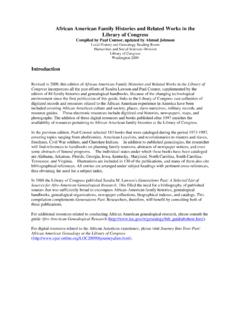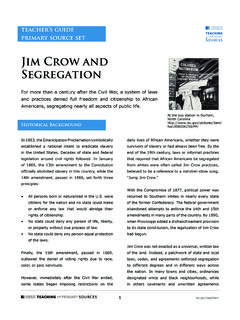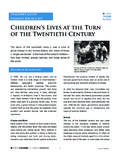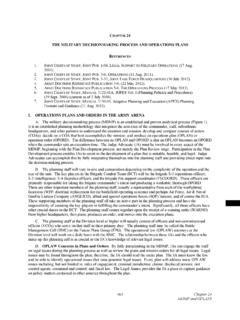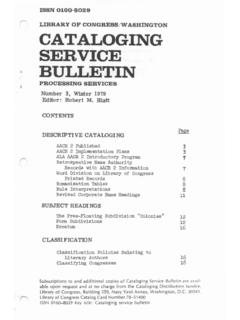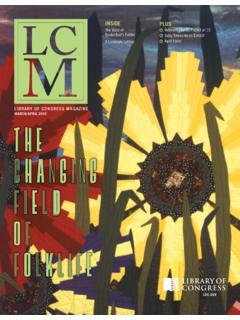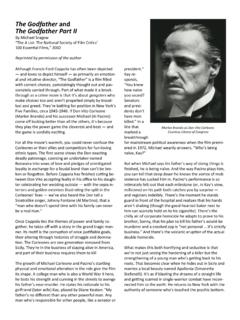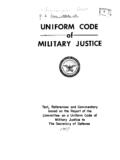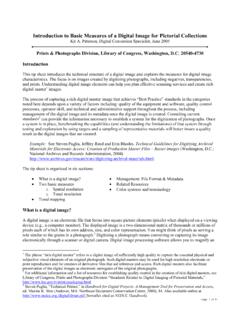Transcription of 12 Angry Men - Library of Congress
1 Twelve Angry Men has become a clas-sic, not just for students of film, but be-cause it is seen so often in high schools as a compelling text to teach civic respon-sibility, social justice, and the importance of standing up for what is right, even against overwhelming odds. It was Sidney Lumet's first feature after seven years of outstanding work in television, and throughout a forty-year career of making movies, he continued to reiterate those themes. Reginald Rose wrote the original play for the CBS series, Studio One, and it aired on September 20, 1954. He says it was based, to a certain extent, on his own experiences as a juror, but it also reflects the era in which it appeared, the so-called McCarthy Era, when standing up for your constitutional rights could get you in trouble.
2 In 1995 Rose admitted, In a way, almost everything I wrote in the 1950s was about McCarthy (Munyan 24) . When Henry Fonda saw it (he was not in the original cast), he asked Rose to adapt the teleplay into a film. Fonda, as co-producer with Rose, chose Lu-met as the director, "because he had a reputation of being wonderful with actors." He also added that he had "incredible organization and awareness of the problem of shooting and not wasting time" (Munyan 53). Lumet developed his directorial abilities during this age of live television and he jumped at the chance to recreate the TV script for film. In the original script, there were only three references that described any kind of camera movement or technique, so Lumet saw this as an opportunity for visual storytelling, to let the camera reflect the emotional and psychologi-cal changes taking place among the twelve jurors.
3 He liked to think of the camera itself as an actor. The movie was shot on location in an actual jury cham-ber, allowing the director the challenge of shooting in a confined space, a challenge at which he would ex-cel throughout his career. Of course, he had the as-sistance of a master of black & white cinematog-raphy--with whom he was to go on to do several more movies--Boris Kaufman. The two wanted visually to create a sense of impris-onment. In a narrative in which twelve men must decide whether young Hispanic boy will live or die, be imprisoned or set free, we are presented with characters who are themselves in their own prisons. To establish this, they created what Lumet called a lens plot.
4 "As the picture unfolded, I wanted the room to seem smaller and smaller. That meant that I would slowly shift to longer lenses as the picture continued .. In addition, I shot the first third of the movie above eye level, and then, by lowering the camera, shot the second third at eye level, and the last third from below eye level" (Lumet 81). The ef-fect is to give the viewer the same feeling of claus-trophobia that is felt by the jurors. Then, for the final shot of the movie, as the jurors are leaving the court-house, Lumet says, "I used a wide angle lens, wider than any lens that had been used in the entire pic-ture. I also raised the camera to the highest above-eye-level position. The intention was literally to give us all air, to let us finally breathe, after two increas-ingly confined hours.
5 (Lumet 81). Lumet, as Fonda knew he would, got outstanding performances from his cast, including Fonda himself as Juror #8, the quiet architect whose reasonable doubt gradually leads the others to question their first instincts about the defendant s guilt. Others in the cast include Martin Balsam as the unconfident foreman, Juror #1, Lee J. Cobb as the tormented Juror #3, unable, until the very end, to overcome his own hateful prejudices, Marshall as Juror #4, a bespectacled stockbroker who doesn t sweat until he begins to doubt his own first impressions, Jack Warden (Juror #7), the marmalade salesman for 12 angry men By Joanna E. Rapf Ed Begley defends his viewpoint to his fellow jurors, including Jack Klugman (standing), Joseph Sweeney and Henry Fonda.
6 Courtesy Library of Congress Collection. whom a ballgame initially takes precedence over de-liberation, and Ed Begley (Juror #10), an Angry , big-oted garage owner. All the characters are nameless until the end when, as they exit the courthouse, we learn that Juror #8 (Fonda) is Davis and Juror #9 is Arnold (Joseph Sweeney). Lumet asked the actors to wear their own clothes. Speaking to them during rehearsal, he said, "There's going to be no artificiality in this. You are going to be the whole picture. This is not a tract. This is not a pro-jury or anti-jury thing. It's .. about human be-havior .. Just you and the fullness of your behav-ior" (Ross). And this behavior represents the diversi-ty of urban New York, from the well-to-do to the low-er classes.
7 Each man brings to the table his own ex-perience. An immigrant watchmaker understands life in the slums and knows how to use a switch-blade (George Voskovec as Juror #11), an advertising salesman thinks and speaks in clich s (Robert Webber as Juror #12), while Juror #9 (Joseph Sweeney) understands what it means to be old and insignificant. It is truly a cross-section of humanity (although there are no women), reflecting, as the re-view in Time noted, that the law is no better than the people who enforce it .. and the people who enforce it are all too human (April 29, 1957, p. 96). Although it did not win, Twelve Angry Men was nominated for three Academy Awards: Best Picture, Best Direction, and Best Screenplay based on mate-rial from another medium.
8 It did win first prize at the Berlin International Film Festival, and in this country, Henry Fonda, Lee J. Cobb, and Sidney Lumet were all nominated for Golden Globes. But it is the content of the movie that is its lasting legacy, allowing it to speak across generations and economic and racial divides. It reflects Lumet's ongoing concern with jus-tice within the legal system, with the importance of moral responsibility, and with the necessity in a bu-reaucratic and mechanized world for personal au-thenticity. Lumet himself has said that the theme of this film is simply: "listen." Works Cited Lumet, Sidney. Making Movies. New York: Vintage, Books, 1995. Munyan, Russ, Ed. Readings on Twelve Angry Men.
9 San Diego: Greenhaven Press Inc., 2000. Ross, Don. A Dozen Happy Actors Become Twelve Angry Men . New York Times (July 15, 1956): sec. 4, p. 3. The views expressed in this essay are those of the author and do not necessarily represent the views of the Library of Congress . Joanna E. Rapf is an Emerita Professor of English and Film & Media Studies from the University of Oklahoma. She has published several essays on Sidney Lumet and edited a volume of interviews with him, including one of her own. She also has books on Buster Keaton, On the Waterfront, and is co-editor of The Blackwell Companion to Film Comedy. Her articles and essays on diverse film subjects have appeared in various volumes and journals.
10
